Critical Evaluation of Clinical Supervision in Mental Healthcare
VerifiedAdded on 2022/12/27
|12
|3536
|68
Essay
AI Summary
This essay critically evaluates the role of clinical supervision in supporting safe and effective mental healthcare. It examines the prevalence of inadequate and harmful supervision, referencing Ellis et al.'s (2014) framework and highlighting the importance of training and awareness for both supervisors and supervisees. The essay discusses essential elements of effective supervision, including competent handling of problems, ethical and legal considerations, and the development of professional relationships. It also outlines arrangements for clinical supervision and explores the role of the author in further developing these arrangements, emphasizing the need for continuous evaluation, feedback, and adherence to ethical standards to enhance the quality of mental healthcare. The essay stresses the importance of creating a safe environment, avoiding bias, and promoting professionalism to ensure the well-being of both clients and supervisees. The essay also discusses the need for structured guidelines, early identification of issues, and the implementation of policies to safeguard ethical practice and minimize vulnerabilities in clinical supervision. The paper emphasizes the importance of multicultural frameworks and outlines the key features in upholding the highest level of supervision.
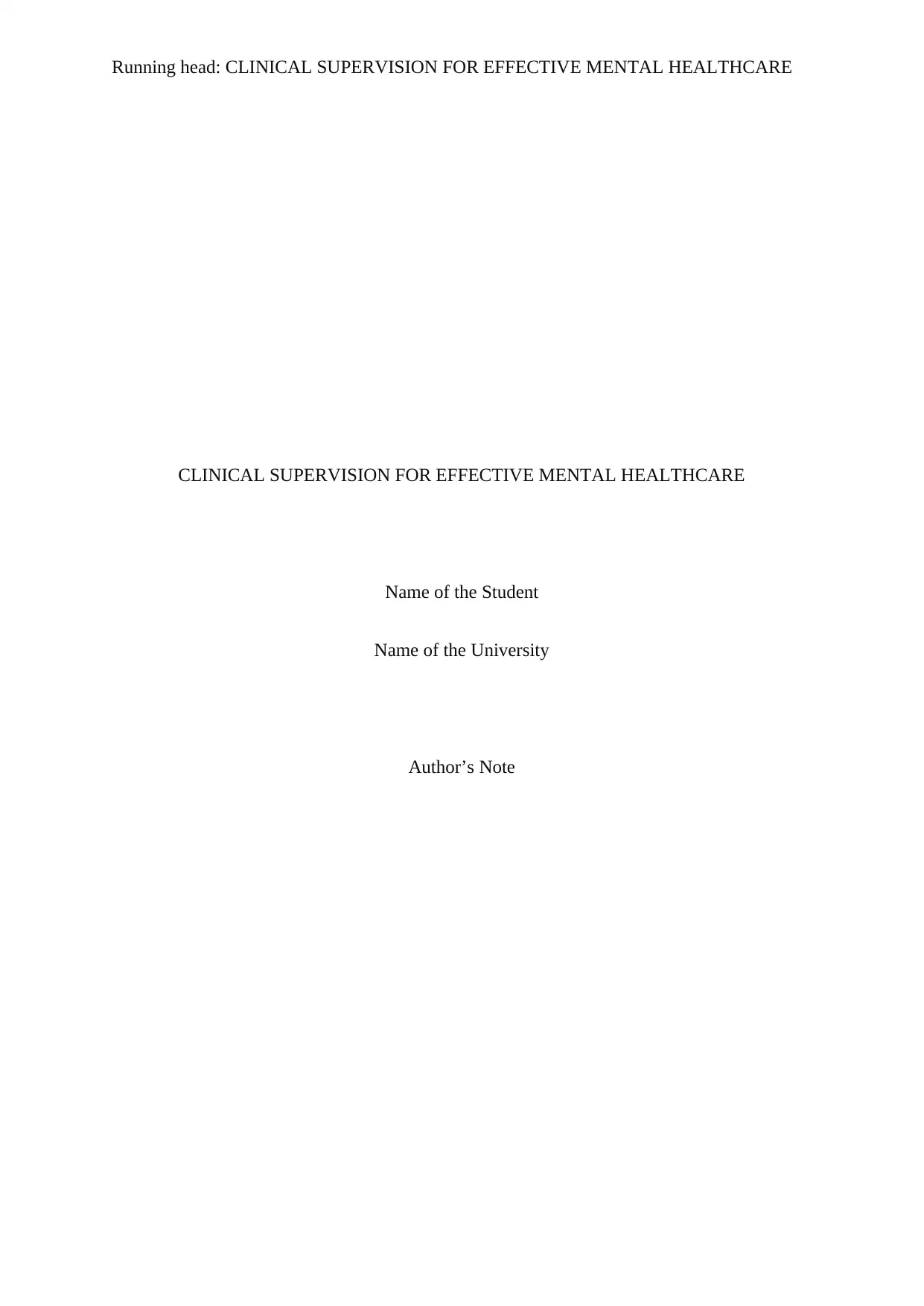
Running head: CLINICAL SUPERVISION FOR EFFECTIVE MENTAL HEALTHCARE
CLINICAL SUPERVISION FOR EFFECTIVE MENTAL HEALTHCARE
Name of the Student
Name of the University
Author’s Note
CLINICAL SUPERVISION FOR EFFECTIVE MENTAL HEALTHCARE
Name of the Student
Name of the University
Author’s Note
Paraphrase This Document
Need a fresh take? Get an instant paraphrase of this document with our AI Paraphraser
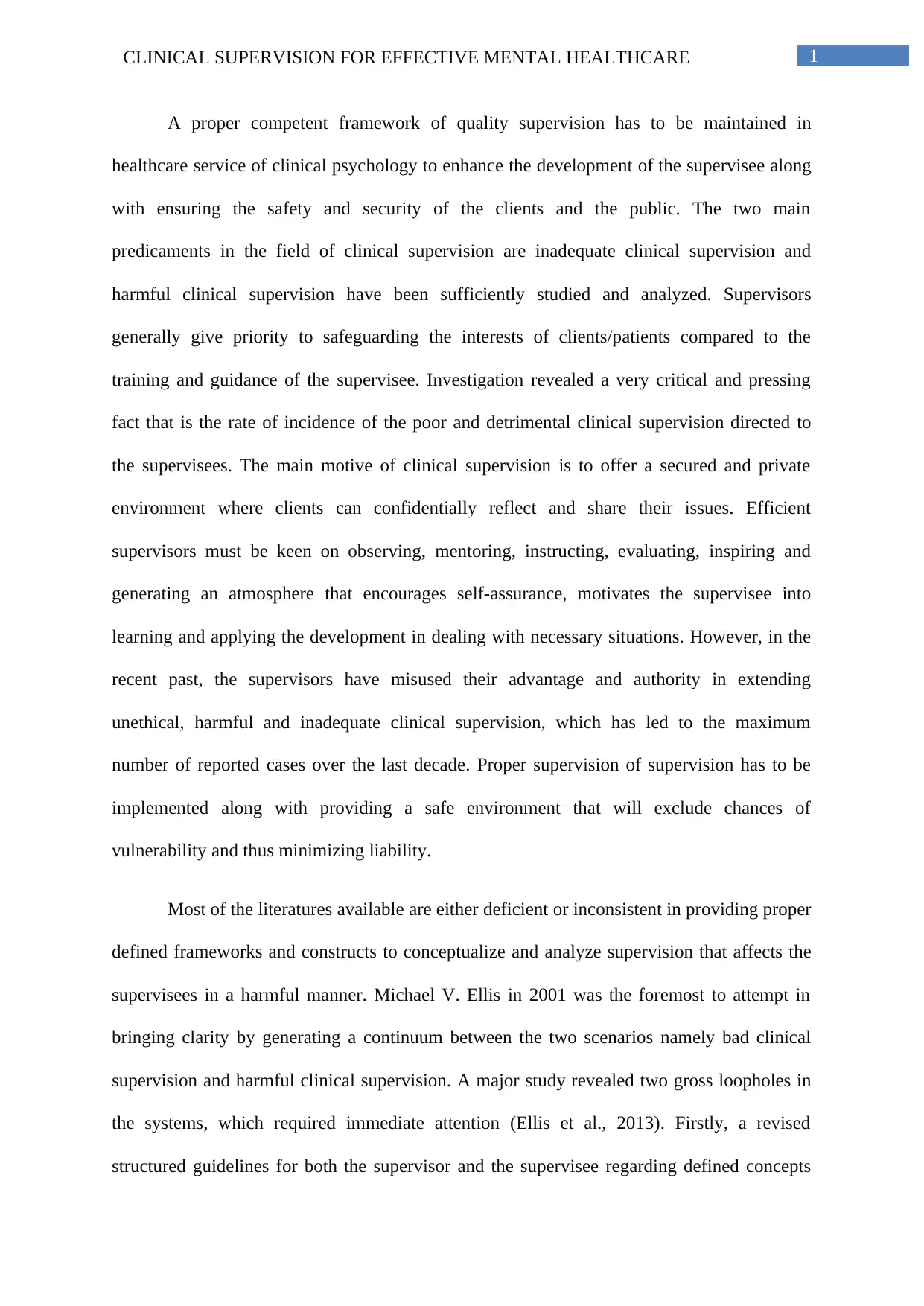
1CLINICAL SUPERVISION FOR EFFECTIVE MENTAL HEALTHCARE
A proper competent framework of quality supervision has to be maintained in
healthcare service of clinical psychology to enhance the development of the supervisee along
with ensuring the safety and security of the clients and the public. The two main
predicaments in the field of clinical supervision are inadequate clinical supervision and
harmful clinical supervision have been sufficiently studied and analyzed. Supervisors
generally give priority to safeguarding the interests of clients/patients compared to the
training and guidance of the supervisee. Investigation revealed a very critical and pressing
fact that is the rate of incidence of the poor and detrimental clinical supervision directed to
the supervisees. The main motive of clinical supervision is to offer a secured and private
environment where clients can confidentially reflect and share their issues. Efficient
supervisors must be keen on observing, mentoring, instructing, evaluating, inspiring and
generating an atmosphere that encourages self-assurance, motivates the supervisee into
learning and applying the development in dealing with necessary situations. However, in the
recent past, the supervisors have misused their advantage and authority in extending
unethical, harmful and inadequate clinical supervision, which has led to the maximum
number of reported cases over the last decade. Proper supervision of supervision has to be
implemented along with providing a safe environment that will exclude chances of
vulnerability and thus minimizing liability.
Most of the literatures available are either deficient or inconsistent in providing proper
defined frameworks and constructs to conceptualize and analyze supervision that affects the
supervisees in a harmful manner. Michael V. Ellis in 2001 was the foremost to attempt in
bringing clarity by generating a continuum between the two scenarios namely bad clinical
supervision and harmful clinical supervision. A major study revealed two gross loopholes in
the systems, which required immediate attention (Ellis et al., 2013). Firstly, a revised
structured guidelines for both the supervisor and the supervisee regarding defined concepts
A proper competent framework of quality supervision has to be maintained in
healthcare service of clinical psychology to enhance the development of the supervisee along
with ensuring the safety and security of the clients and the public. The two main
predicaments in the field of clinical supervision are inadequate clinical supervision and
harmful clinical supervision have been sufficiently studied and analyzed. Supervisors
generally give priority to safeguarding the interests of clients/patients compared to the
training and guidance of the supervisee. Investigation revealed a very critical and pressing
fact that is the rate of incidence of the poor and detrimental clinical supervision directed to
the supervisees. The main motive of clinical supervision is to offer a secured and private
environment where clients can confidentially reflect and share their issues. Efficient
supervisors must be keen on observing, mentoring, instructing, evaluating, inspiring and
generating an atmosphere that encourages self-assurance, motivates the supervisee into
learning and applying the development in dealing with necessary situations. However, in the
recent past, the supervisors have misused their advantage and authority in extending
unethical, harmful and inadequate clinical supervision, which has led to the maximum
number of reported cases over the last decade. Proper supervision of supervision has to be
implemented along with providing a safe environment that will exclude chances of
vulnerability and thus minimizing liability.
Most of the literatures available are either deficient or inconsistent in providing proper
defined frameworks and constructs to conceptualize and analyze supervision that affects the
supervisees in a harmful manner. Michael V. Ellis in 2001 was the foremost to attempt in
bringing clarity by generating a continuum between the two scenarios namely bad clinical
supervision and harmful clinical supervision. A major study revealed two gross loopholes in
the systems, which required immediate attention (Ellis et al., 2013). Firstly, a revised
structured guidelines for both the supervisor and the supervisee regarding defined concepts
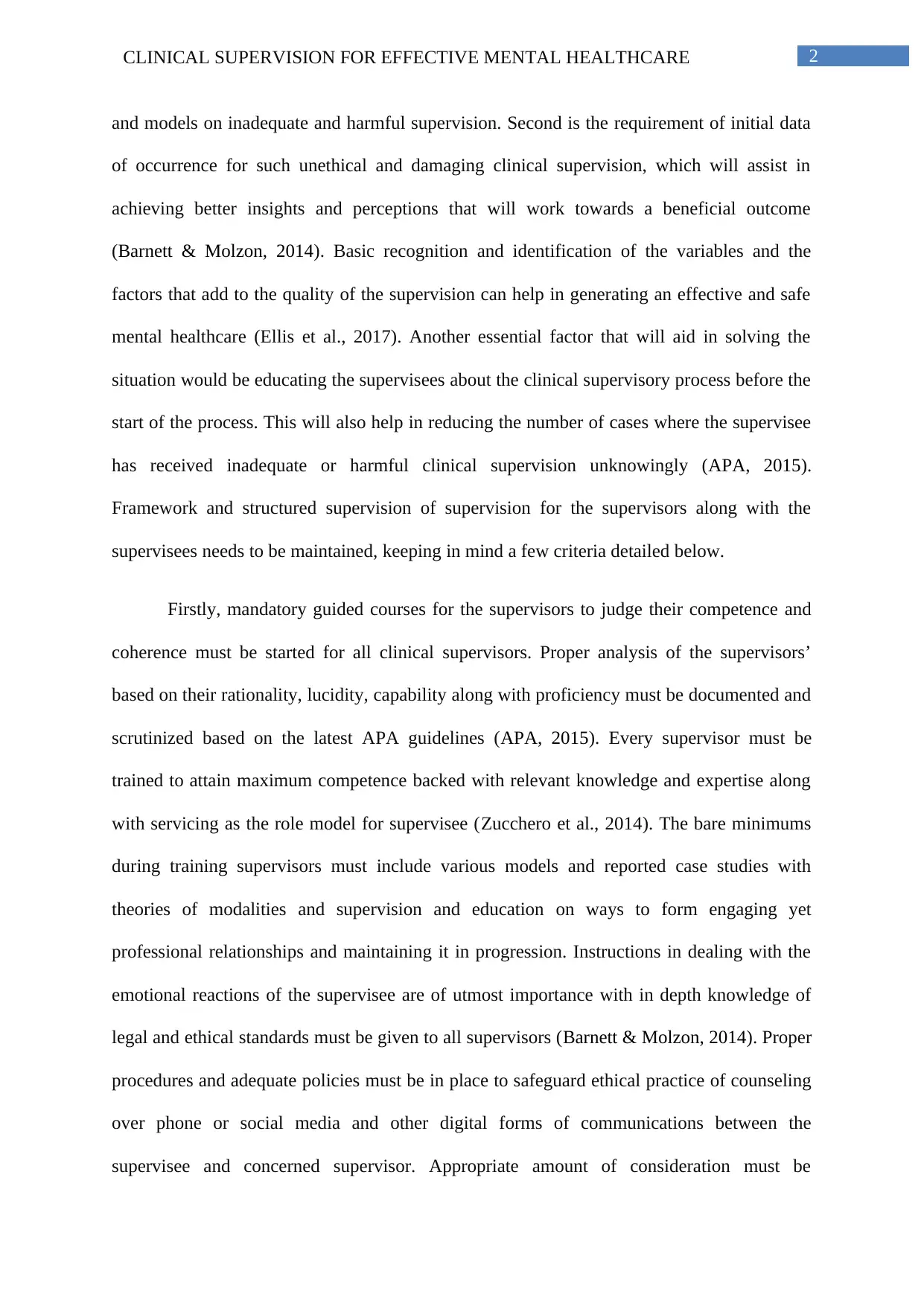
2CLINICAL SUPERVISION FOR EFFECTIVE MENTAL HEALTHCARE
and models on inadequate and harmful supervision. Second is the requirement of initial data
of occurrence for such unethical and damaging clinical supervision, which will assist in
achieving better insights and perceptions that will work towards a beneficial outcome
(Barnett & Molzon, 2014). Basic recognition and identification of the variables and the
factors that add to the quality of the supervision can help in generating an effective and safe
mental healthcare (Ellis et al., 2017). Another essential factor that will aid in solving the
situation would be educating the supervisees about the clinical supervisory process before the
start of the process. This will also help in reducing the number of cases where the supervisee
has received inadequate or harmful clinical supervision unknowingly (APA, 2015).
Framework and structured supervision of supervision for the supervisors along with the
supervisees needs to be maintained, keeping in mind a few criteria detailed below.
Firstly, mandatory guided courses for the supervisors to judge their competence and
coherence must be started for all clinical supervisors. Proper analysis of the supervisors’
based on their rationality, lucidity, capability along with proficiency must be documented and
scrutinized based on the latest APA guidelines (APA, 2015). Every supervisor must be
trained to attain maximum competence backed with relevant knowledge and expertise along
with servicing as the role model for supervisee (Zucchero et al., 2014). The bare minimums
during training supervisors must include various models and reported case studies with
theories of modalities and supervision and education on ways to form engaging yet
professional relationships and maintaining it in progression. Instructions in dealing with the
emotional reactions of the supervisee are of utmost importance with in depth knowledge of
legal and ethical standards must be given to all supervisors (Barnett & Molzon, 2014). Proper
procedures and adequate policies must be in place to safeguard ethical practice of counseling
over phone or social media and other digital forms of communications between the
supervisee and concerned supervisor. Appropriate amount of consideration must be
and models on inadequate and harmful supervision. Second is the requirement of initial data
of occurrence for such unethical and damaging clinical supervision, which will assist in
achieving better insights and perceptions that will work towards a beneficial outcome
(Barnett & Molzon, 2014). Basic recognition and identification of the variables and the
factors that add to the quality of the supervision can help in generating an effective and safe
mental healthcare (Ellis et al., 2017). Another essential factor that will aid in solving the
situation would be educating the supervisees about the clinical supervisory process before the
start of the process. This will also help in reducing the number of cases where the supervisee
has received inadequate or harmful clinical supervision unknowingly (APA, 2015).
Framework and structured supervision of supervision for the supervisors along with the
supervisees needs to be maintained, keeping in mind a few criteria detailed below.
Firstly, mandatory guided courses for the supervisors to judge their competence and
coherence must be started for all clinical supervisors. Proper analysis of the supervisors’
based on their rationality, lucidity, capability along with proficiency must be documented and
scrutinized based on the latest APA guidelines (APA, 2015). Every supervisor must be
trained to attain maximum competence backed with relevant knowledge and expertise along
with servicing as the role model for supervisee (Zucchero et al., 2014). The bare minimums
during training supervisors must include various models and reported case studies with
theories of modalities and supervision and education on ways to form engaging yet
professional relationships and maintaining it in progression. Instructions in dealing with the
emotional reactions of the supervisee are of utmost importance with in depth knowledge of
legal and ethical standards must be given to all supervisors (Barnett & Molzon, 2014). Proper
procedures and adequate policies must be in place to safeguard ethical practice of counseling
over phone or social media and other digital forms of communications between the
supervisee and concerned supervisor. Appropriate amount of consideration must be
⊘ This is a preview!⊘
Do you want full access?
Subscribe today to unlock all pages.

Trusted by 1+ million students worldwide
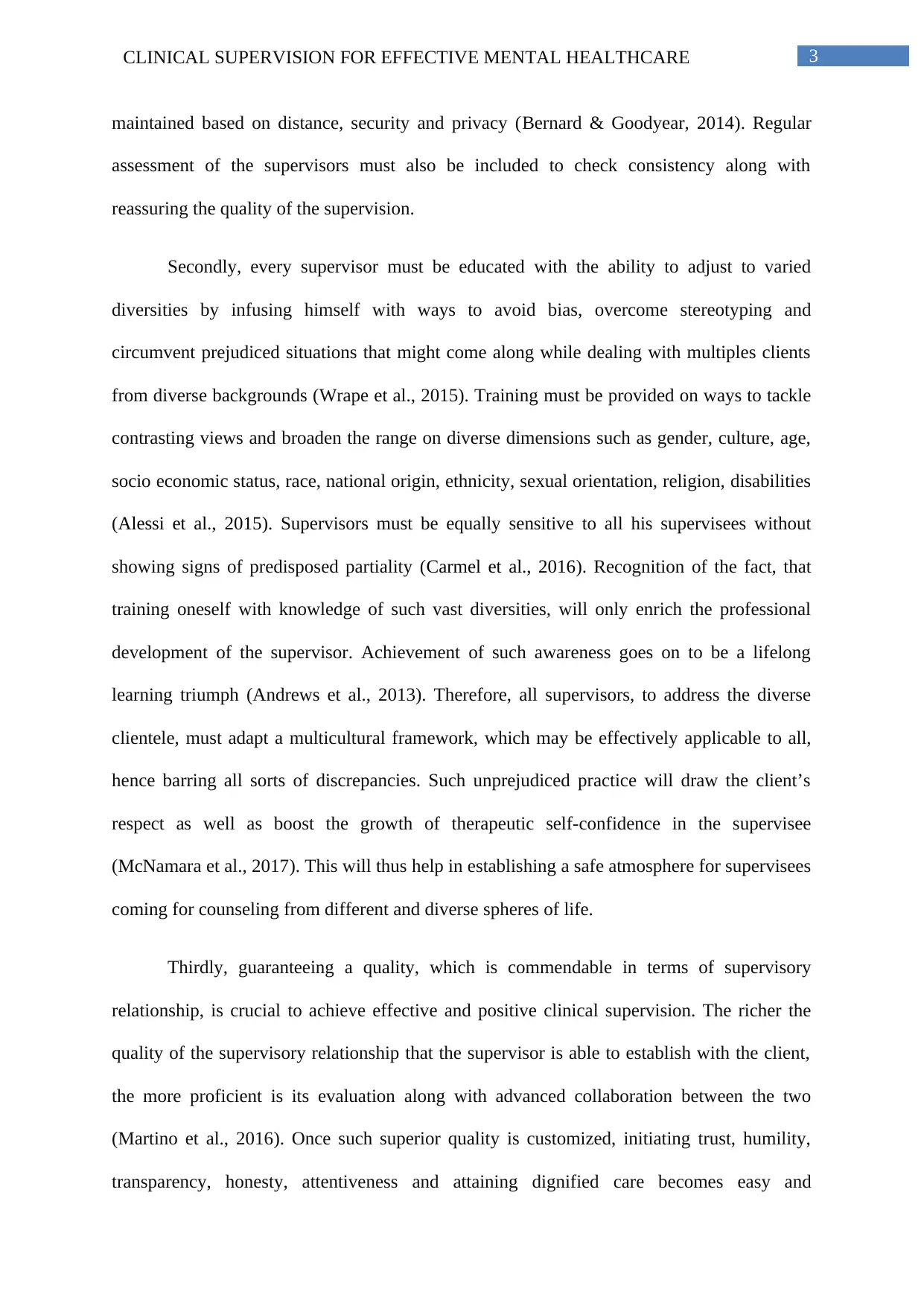
3CLINICAL SUPERVISION FOR EFFECTIVE MENTAL HEALTHCARE
maintained based on distance, security and privacy (Bernard & Goodyear, 2014). Regular
assessment of the supervisors must also be included to check consistency along with
reassuring the quality of the supervision.
Secondly, every supervisor must be educated with the ability to adjust to varied
diversities by infusing himself with ways to avoid bias, overcome stereotyping and
circumvent prejudiced situations that might come along while dealing with multiples clients
from diverse backgrounds (Wrape et al., 2015). Training must be provided on ways to tackle
contrasting views and broaden the range on diverse dimensions such as gender, culture, age,
socio economic status, race, national origin, ethnicity, sexual orientation, religion, disabilities
(Alessi et al., 2015). Supervisors must be equally sensitive to all his supervisees without
showing signs of predisposed partiality (Carmel et al., 2016). Recognition of the fact, that
training oneself with knowledge of such vast diversities, will only enrich the professional
development of the supervisor. Achievement of such awareness goes on to be a lifelong
learning triumph (Andrews et al., 2013). Therefore, all supervisors, to address the diverse
clientele, must adapt a multicultural framework, which may be effectively applicable to all,
hence barring all sorts of discrepancies. Such unprejudiced practice will draw the client’s
respect as well as boost the growth of therapeutic self-confidence in the supervisee
(McNamara et al., 2017). This will thus help in establishing a safe atmosphere for supervisees
coming for counseling from different and diverse spheres of life.
Thirdly, guaranteeing a quality, which is commendable in terms of supervisory
relationship, is crucial to achieve effective and positive clinical supervision. The richer the
quality of the supervisory relationship that the supervisor is able to establish with the client,
the more proficient is its evaluation along with advanced collaboration between the two
(Martino et al., 2016). Once such superior quality is customized, initiating trust, humility,
transparency, honesty, attentiveness and attaining dignified care becomes easy and
maintained based on distance, security and privacy (Bernard & Goodyear, 2014). Regular
assessment of the supervisors must also be included to check consistency along with
reassuring the quality of the supervision.
Secondly, every supervisor must be educated with the ability to adjust to varied
diversities by infusing himself with ways to avoid bias, overcome stereotyping and
circumvent prejudiced situations that might come along while dealing with multiples clients
from diverse backgrounds (Wrape et al., 2015). Training must be provided on ways to tackle
contrasting views and broaden the range on diverse dimensions such as gender, culture, age,
socio economic status, race, national origin, ethnicity, sexual orientation, religion, disabilities
(Alessi et al., 2015). Supervisors must be equally sensitive to all his supervisees without
showing signs of predisposed partiality (Carmel et al., 2016). Recognition of the fact, that
training oneself with knowledge of such vast diversities, will only enrich the professional
development of the supervisor. Achievement of such awareness goes on to be a lifelong
learning triumph (Andrews et al., 2013). Therefore, all supervisors, to address the diverse
clientele, must adapt a multicultural framework, which may be effectively applicable to all,
hence barring all sorts of discrepancies. Such unprejudiced practice will draw the client’s
respect as well as boost the growth of therapeutic self-confidence in the supervisee
(McNamara et al., 2017). This will thus help in establishing a safe atmosphere for supervisees
coming for counseling from different and diverse spheres of life.
Thirdly, guaranteeing a quality, which is commendable in terms of supervisory
relationship, is crucial to achieve effective and positive clinical supervision. The richer the
quality of the supervisory relationship that the supervisor is able to establish with the client,
the more proficient is its evaluation along with advanced collaboration between the two
(Martino et al., 2016). Once such superior quality is customized, initiating trust, humility,
transparency, honesty, attentiveness and attaining dignified care becomes easy and
Paraphrase This Document
Need a fresh take? Get an instant paraphrase of this document with our AI Paraphraser
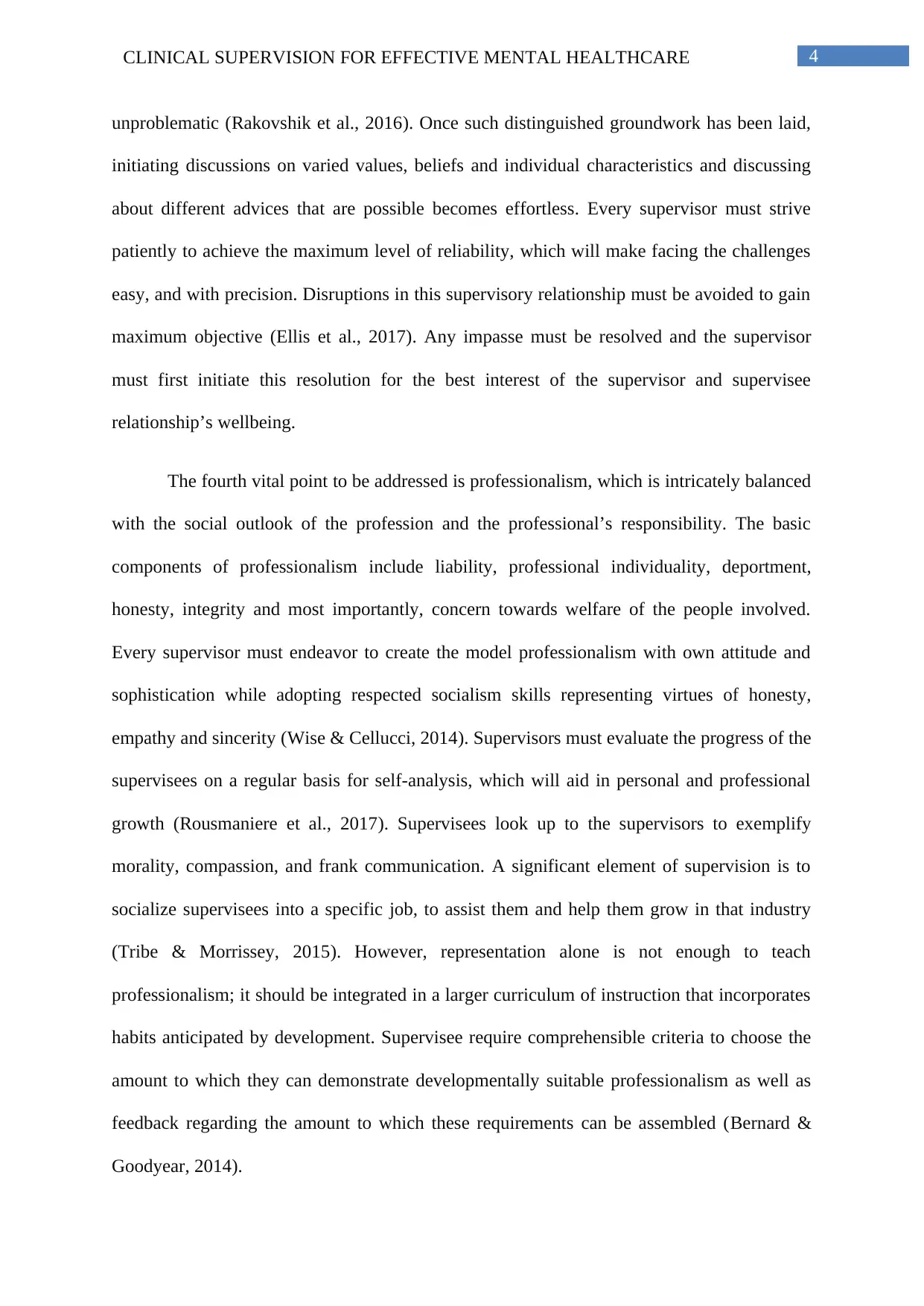
4CLINICAL SUPERVISION FOR EFFECTIVE MENTAL HEALTHCARE
unproblematic (Rakovshik et al., 2016). Once such distinguished groundwork has been laid,
initiating discussions on varied values, beliefs and individual characteristics and discussing
about different advices that are possible becomes effortless. Every supervisor must strive
patiently to achieve the maximum level of reliability, which will make facing the challenges
easy, and with precision. Disruptions in this supervisory relationship must be avoided to gain
maximum objective (Ellis et al., 2017). Any impasse must be resolved and the supervisor
must first initiate this resolution for the best interest of the supervisor and supervisee
relationship’s wellbeing.
The fourth vital point to be addressed is professionalism, which is intricately balanced
with the social outlook of the profession and the professional’s responsibility. The basic
components of professionalism include liability, professional individuality, deportment,
honesty, integrity and most importantly, concern towards welfare of the people involved.
Every supervisor must endeavor to create the model professionalism with own attitude and
sophistication while adopting respected socialism skills representing virtues of honesty,
empathy and sincerity (Wise & Cellucci, 2014). Supervisors must evaluate the progress of the
supervisees on a regular basis for self-analysis, which will aid in personal and professional
growth (Rousmaniere et al., 2017). Supervisees look up to the supervisors to exemplify
morality, compassion, and frank communication. A significant element of supervision is to
socialize supervisees into a specific job, to assist them and help them grow in that industry
(Tribe & Morrissey, 2015). However, representation alone is not enough to teach
professionalism; it should be integrated in a larger curriculum of instruction that incorporates
habits anticipated by development. Supervisee require comprehensible criteria to choose the
amount to which they can demonstrate developmentally suitable professionalism as well as
feedback regarding the amount to which these requirements can be assembled (Bernard &
Goodyear, 2014).
unproblematic (Rakovshik et al., 2016). Once such distinguished groundwork has been laid,
initiating discussions on varied values, beliefs and individual characteristics and discussing
about different advices that are possible becomes effortless. Every supervisor must strive
patiently to achieve the maximum level of reliability, which will make facing the challenges
easy, and with precision. Disruptions in this supervisory relationship must be avoided to gain
maximum objective (Ellis et al., 2017). Any impasse must be resolved and the supervisor
must first initiate this resolution for the best interest of the supervisor and supervisee
relationship’s wellbeing.
The fourth vital point to be addressed is professionalism, which is intricately balanced
with the social outlook of the profession and the professional’s responsibility. The basic
components of professionalism include liability, professional individuality, deportment,
honesty, integrity and most importantly, concern towards welfare of the people involved.
Every supervisor must endeavor to create the model professionalism with own attitude and
sophistication while adopting respected socialism skills representing virtues of honesty,
empathy and sincerity (Wise & Cellucci, 2014). Supervisors must evaluate the progress of the
supervisees on a regular basis for self-analysis, which will aid in personal and professional
growth (Rousmaniere et al., 2017). Supervisees look up to the supervisors to exemplify
morality, compassion, and frank communication. A significant element of supervision is to
socialize supervisees into a specific job, to assist them and help them grow in that industry
(Tribe & Morrissey, 2015). However, representation alone is not enough to teach
professionalism; it should be integrated in a larger curriculum of instruction that incorporates
habits anticipated by development. Supervisee require comprehensible criteria to choose the
amount to which they can demonstrate developmentally suitable professionalism as well as
feedback regarding the amount to which these requirements can be assembled (Bernard &
Goodyear, 2014).
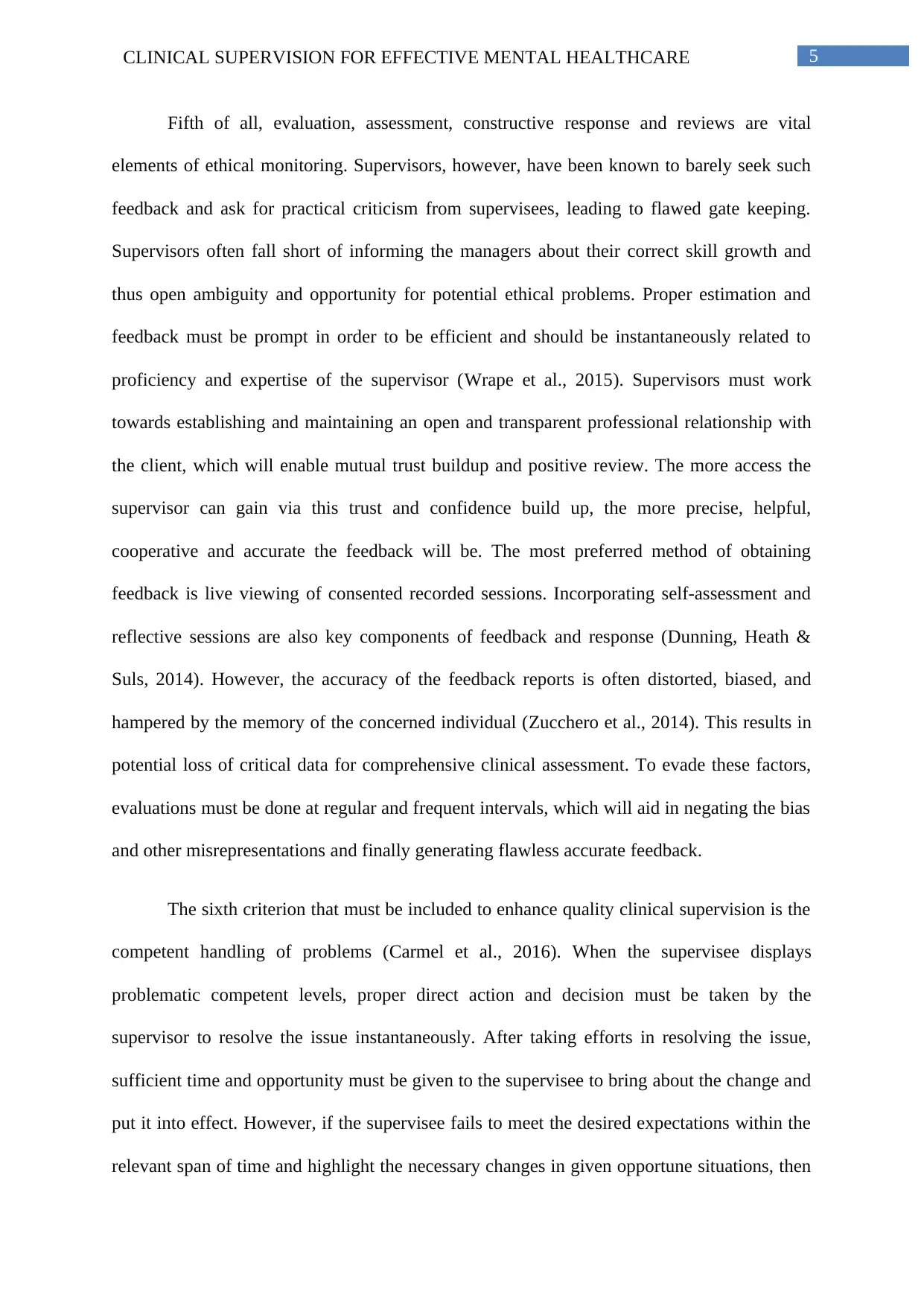
5CLINICAL SUPERVISION FOR EFFECTIVE MENTAL HEALTHCARE
Fifth of all, evaluation, assessment, constructive response and reviews are vital
elements of ethical monitoring. Supervisors, however, have been known to barely seek such
feedback and ask for practical criticism from supervisees, leading to flawed gate keeping.
Supervisors often fall short of informing the managers about their correct skill growth and
thus open ambiguity and opportunity for potential ethical problems. Proper estimation and
feedback must be prompt in order to be efficient and should be instantaneously related to
proficiency and expertise of the supervisor (Wrape et al., 2015). Supervisors must work
towards establishing and maintaining an open and transparent professional relationship with
the client, which will enable mutual trust buildup and positive review. The more access the
supervisor can gain via this trust and confidence build up, the more precise, helpful,
cooperative and accurate the feedback will be. The most preferred method of obtaining
feedback is live viewing of consented recorded sessions. Incorporating self-assessment and
reflective sessions are also key components of feedback and response (Dunning, Heath &
Suls, 2014). However, the accuracy of the feedback reports is often distorted, biased, and
hampered by the memory of the concerned individual (Zucchero et al., 2014). This results in
potential loss of critical data for comprehensive clinical assessment. To evade these factors,
evaluations must be done at regular and frequent intervals, which will aid in negating the bias
and other misrepresentations and finally generating flawless accurate feedback.
The sixth criterion that must be included to enhance quality clinical supervision is the
competent handling of problems (Carmel et al., 2016). When the supervisee displays
problematic competent levels, proper direct action and decision must be taken by the
supervisor to resolve the issue instantaneously. After taking efforts in resolving the issue,
sufficient time and opportunity must be given to the supervisee to bring about the change and
put it into effect. However, if the supervisee fails to meet the desired expectations within the
relevant span of time and highlight the necessary changes in given opportune situations, then
Fifth of all, evaluation, assessment, constructive response and reviews are vital
elements of ethical monitoring. Supervisors, however, have been known to barely seek such
feedback and ask for practical criticism from supervisees, leading to flawed gate keeping.
Supervisors often fall short of informing the managers about their correct skill growth and
thus open ambiguity and opportunity for potential ethical problems. Proper estimation and
feedback must be prompt in order to be efficient and should be instantaneously related to
proficiency and expertise of the supervisor (Wrape et al., 2015). Supervisors must work
towards establishing and maintaining an open and transparent professional relationship with
the client, which will enable mutual trust buildup and positive review. The more access the
supervisor can gain via this trust and confidence build up, the more precise, helpful,
cooperative and accurate the feedback will be. The most preferred method of obtaining
feedback is live viewing of consented recorded sessions. Incorporating self-assessment and
reflective sessions are also key components of feedback and response (Dunning, Heath &
Suls, 2014). However, the accuracy of the feedback reports is often distorted, biased, and
hampered by the memory of the concerned individual (Zucchero et al., 2014). This results in
potential loss of critical data for comprehensive clinical assessment. To evade these factors,
evaluations must be done at regular and frequent intervals, which will aid in negating the bias
and other misrepresentations and finally generating flawless accurate feedback.
The sixth criterion that must be included to enhance quality clinical supervision is the
competent handling of problems (Carmel et al., 2016). When the supervisee displays
problematic competent levels, proper direct action and decision must be taken by the
supervisor to resolve the issue instantaneously. After taking efforts in resolving the issue,
sufficient time and opportunity must be given to the supervisee to bring about the change and
put it into effect. However, if the supervisee fails to meet the desired expectations within the
relevant span of time and highlight the necessary changes in given opportune situations, then
⊘ This is a preview!⊘
Do you want full access?
Subscribe today to unlock all pages.

Trusted by 1+ million students worldwide
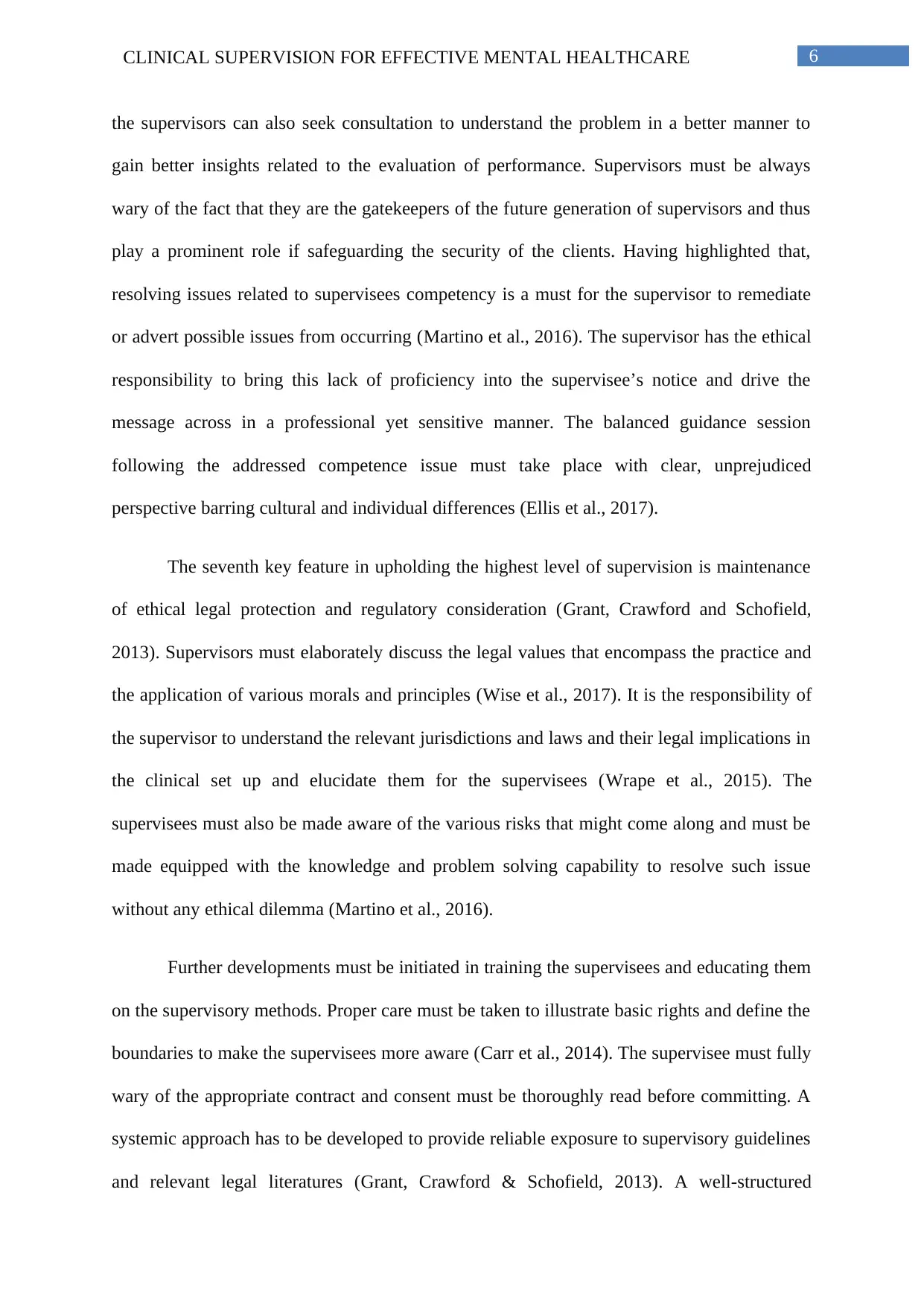
6CLINICAL SUPERVISION FOR EFFECTIVE MENTAL HEALTHCARE
the supervisors can also seek consultation to understand the problem in a better manner to
gain better insights related to the evaluation of performance. Supervisors must be always
wary of the fact that they are the gatekeepers of the future generation of supervisors and thus
play a prominent role if safeguarding the security of the clients. Having highlighted that,
resolving issues related to supervisees competency is a must for the supervisor to remediate
or advert possible issues from occurring (Martino et al., 2016). The supervisor has the ethical
responsibility to bring this lack of proficiency into the supervisee’s notice and drive the
message across in a professional yet sensitive manner. The balanced guidance session
following the addressed competence issue must take place with clear, unprejudiced
perspective barring cultural and individual differences (Ellis et al., 2017).
The seventh key feature in upholding the highest level of supervision is maintenance
of ethical legal protection and regulatory consideration (Grant, Crawford and Schofield,
2013). Supervisors must elaborately discuss the legal values that encompass the practice and
the application of various morals and principles (Wise et al., 2017). It is the responsibility of
the supervisor to understand the relevant jurisdictions and laws and their legal implications in
the clinical set up and elucidate them for the supervisees (Wrape et al., 2015). The
supervisees must also be made aware of the various risks that might come along and must be
made equipped with the knowledge and problem solving capability to resolve such issue
without any ethical dilemma (Martino et al., 2016).
Further developments must be initiated in training the supervisees and educating them
on the supervisory methods. Proper care must be taken to illustrate basic rights and define the
boundaries to make the supervisees more aware (Carr et al., 2014). The supervisee must fully
wary of the appropriate contract and consent must be thoroughly read before committing. A
systemic approach has to be developed to provide reliable exposure to supervisory guidelines
and relevant legal literatures (Grant, Crawford & Schofield, 2013). A well-structured
the supervisors can also seek consultation to understand the problem in a better manner to
gain better insights related to the evaluation of performance. Supervisors must be always
wary of the fact that they are the gatekeepers of the future generation of supervisors and thus
play a prominent role if safeguarding the security of the clients. Having highlighted that,
resolving issues related to supervisees competency is a must for the supervisor to remediate
or advert possible issues from occurring (Martino et al., 2016). The supervisor has the ethical
responsibility to bring this lack of proficiency into the supervisee’s notice and drive the
message across in a professional yet sensitive manner. The balanced guidance session
following the addressed competence issue must take place with clear, unprejudiced
perspective barring cultural and individual differences (Ellis et al., 2017).
The seventh key feature in upholding the highest level of supervision is maintenance
of ethical legal protection and regulatory consideration (Grant, Crawford and Schofield,
2013). Supervisors must elaborately discuss the legal values that encompass the practice and
the application of various morals and principles (Wise et al., 2017). It is the responsibility of
the supervisor to understand the relevant jurisdictions and laws and their legal implications in
the clinical set up and elucidate them for the supervisees (Wrape et al., 2015). The
supervisees must also be made aware of the various risks that might come along and must be
made equipped with the knowledge and problem solving capability to resolve such issue
without any ethical dilemma (Martino et al., 2016).
Further developments must be initiated in training the supervisees and educating them
on the supervisory methods. Proper care must be taken to illustrate basic rights and define the
boundaries to make the supervisees more aware (Carr et al., 2014). The supervisee must fully
wary of the appropriate contract and consent must be thoroughly read before committing. A
systemic approach has to be developed to provide reliable exposure to supervisory guidelines
and relevant legal literatures (Grant, Crawford & Schofield, 2013). A well-structured
Paraphrase This Document
Need a fresh take? Get an instant paraphrase of this document with our AI Paraphraser
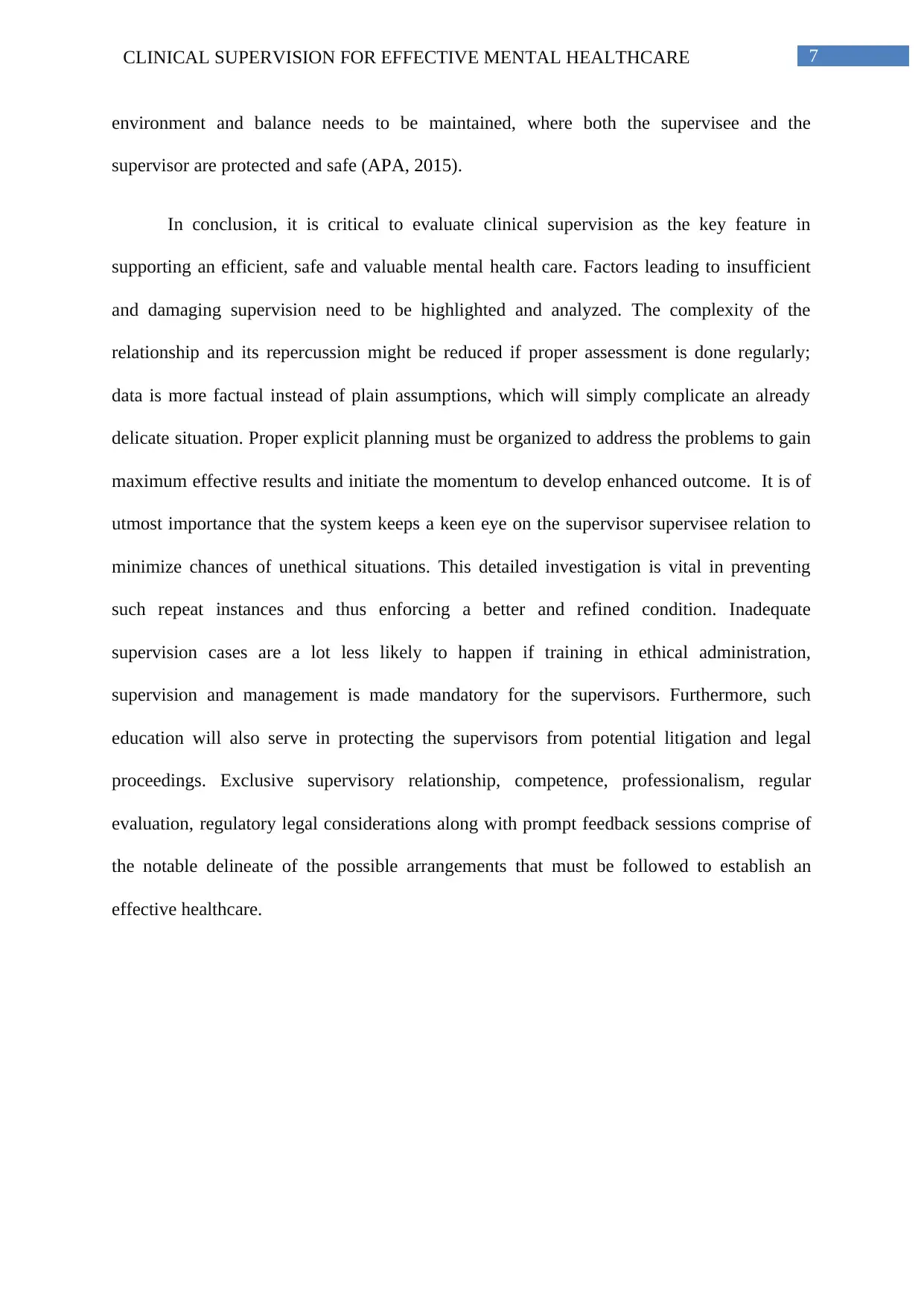
7CLINICAL SUPERVISION FOR EFFECTIVE MENTAL HEALTHCARE
environment and balance needs to be maintained, where both the supervisee and the
supervisor are protected and safe (APA, 2015).
In conclusion, it is critical to evaluate clinical supervision as the key feature in
supporting an efficient, safe and valuable mental health care. Factors leading to insufficient
and damaging supervision need to be highlighted and analyzed. The complexity of the
relationship and its repercussion might be reduced if proper assessment is done regularly;
data is more factual instead of plain assumptions, which will simply complicate an already
delicate situation. Proper explicit planning must be organized to address the problems to gain
maximum effective results and initiate the momentum to develop enhanced outcome. It is of
utmost importance that the system keeps a keen eye on the supervisor supervisee relation to
minimize chances of unethical situations. This detailed investigation is vital in preventing
such repeat instances and thus enforcing a better and refined condition. Inadequate
supervision cases are a lot less likely to happen if training in ethical administration,
supervision and management is made mandatory for the supervisors. Furthermore, such
education will also serve in protecting the supervisors from potential litigation and legal
proceedings. Exclusive supervisory relationship, competence, professionalism, regular
evaluation, regulatory legal considerations along with prompt feedback sessions comprise of
the notable delineate of the possible arrangements that must be followed to establish an
effective healthcare.
environment and balance needs to be maintained, where both the supervisee and the
supervisor are protected and safe (APA, 2015).
In conclusion, it is critical to evaluate clinical supervision as the key feature in
supporting an efficient, safe and valuable mental health care. Factors leading to insufficient
and damaging supervision need to be highlighted and analyzed. The complexity of the
relationship and its repercussion might be reduced if proper assessment is done regularly;
data is more factual instead of plain assumptions, which will simply complicate an already
delicate situation. Proper explicit planning must be organized to address the problems to gain
maximum effective results and initiate the momentum to develop enhanced outcome. It is of
utmost importance that the system keeps a keen eye on the supervisor supervisee relation to
minimize chances of unethical situations. This detailed investigation is vital in preventing
such repeat instances and thus enforcing a better and refined condition. Inadequate
supervision cases are a lot less likely to happen if training in ethical administration,
supervision and management is made mandatory for the supervisors. Furthermore, such
education will also serve in protecting the supervisors from potential litigation and legal
proceedings. Exclusive supervisory relationship, competence, professionalism, regular
evaluation, regulatory legal considerations along with prompt feedback sessions comprise of
the notable delineate of the possible arrangements that must be followed to establish an
effective healthcare.
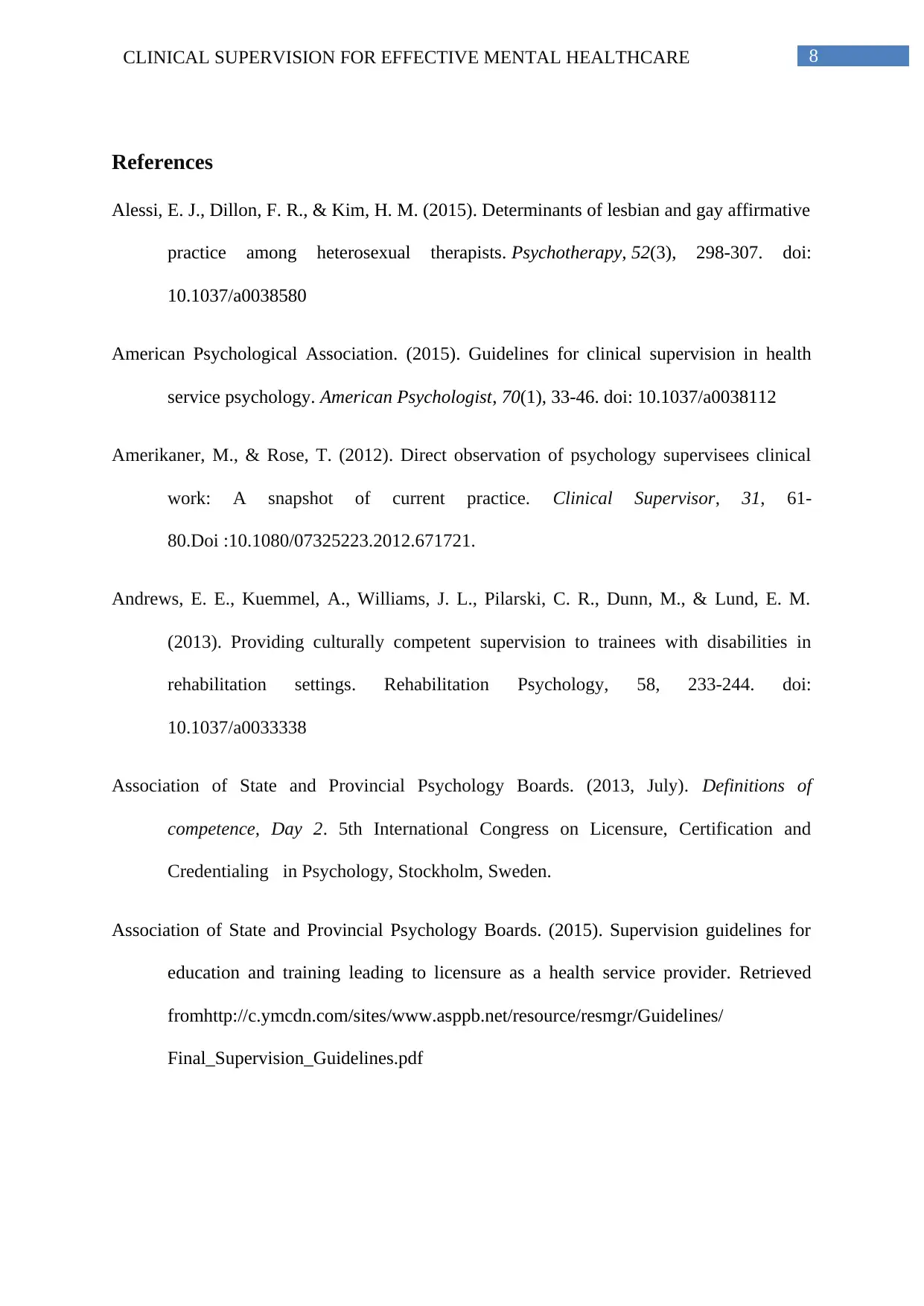
8CLINICAL SUPERVISION FOR EFFECTIVE MENTAL HEALTHCARE
References
Alessi, E. J., Dillon, F. R., & Kim, H. M. (2015). Determinants of lesbian and gay affirmative
practice among heterosexual therapists. Psychotherapy, 52(3), 298-307. doi:
10.1037/a0038580
American Psychological Association. (2015). Guidelines for clinical supervision in health
service psychology. American Psychologist, 70(1), 33-46. doi: 10.1037/a0038112
Amerikaner, M., & Rose, T. (2012). Direct observation of psychology supervisees clinical
work: A snapshot of current practice. Clinical Supervisor, 31, 61-
80.Doi :10.1080/07325223.2012.671721.
Andrews, E. E., Kuemmel, A., Williams, J. L., Pilarski, C. R., Dunn, M., & Lund, E. M.
(2013). Providing culturally competent supervision to trainees with disabilities in
rehabilitation settings. Rehabilitation Psychology, 58, 233-244. doi:
10.1037/a0033338
Association of State and Provincial Psychology Boards. (2013, July). Definitions of
competence, Day 2. 5th International Congress on Licensure, Certification and
Credentialing in Psychology, Stockholm, Sweden.
Association of State and Provincial Psychology Boards. (2015). Supervision guidelines for
education and training leading to licensure as a health service provider. Retrieved
fromhttp://c.ymcdn.com/sites/www.asppb.net/resource/resmgr/Guidelines/
Final_Supervision_Guidelines.pdf
References
Alessi, E. J., Dillon, F. R., & Kim, H. M. (2015). Determinants of lesbian and gay affirmative
practice among heterosexual therapists. Psychotherapy, 52(3), 298-307. doi:
10.1037/a0038580
American Psychological Association. (2015). Guidelines for clinical supervision in health
service psychology. American Psychologist, 70(1), 33-46. doi: 10.1037/a0038112
Amerikaner, M., & Rose, T. (2012). Direct observation of psychology supervisees clinical
work: A snapshot of current practice. Clinical Supervisor, 31, 61-
80.Doi :10.1080/07325223.2012.671721.
Andrews, E. E., Kuemmel, A., Williams, J. L., Pilarski, C. R., Dunn, M., & Lund, E. M.
(2013). Providing culturally competent supervision to trainees with disabilities in
rehabilitation settings. Rehabilitation Psychology, 58, 233-244. doi:
10.1037/a0033338
Association of State and Provincial Psychology Boards. (2013, July). Definitions of
competence, Day 2. 5th International Congress on Licensure, Certification and
Credentialing in Psychology, Stockholm, Sweden.
Association of State and Provincial Psychology Boards. (2015). Supervision guidelines for
education and training leading to licensure as a health service provider. Retrieved
fromhttp://c.ymcdn.com/sites/www.asppb.net/resource/resmgr/Guidelines/
Final_Supervision_Guidelines.pdf
⊘ This is a preview!⊘
Do you want full access?
Subscribe today to unlock all pages.

Trusted by 1+ million students worldwide
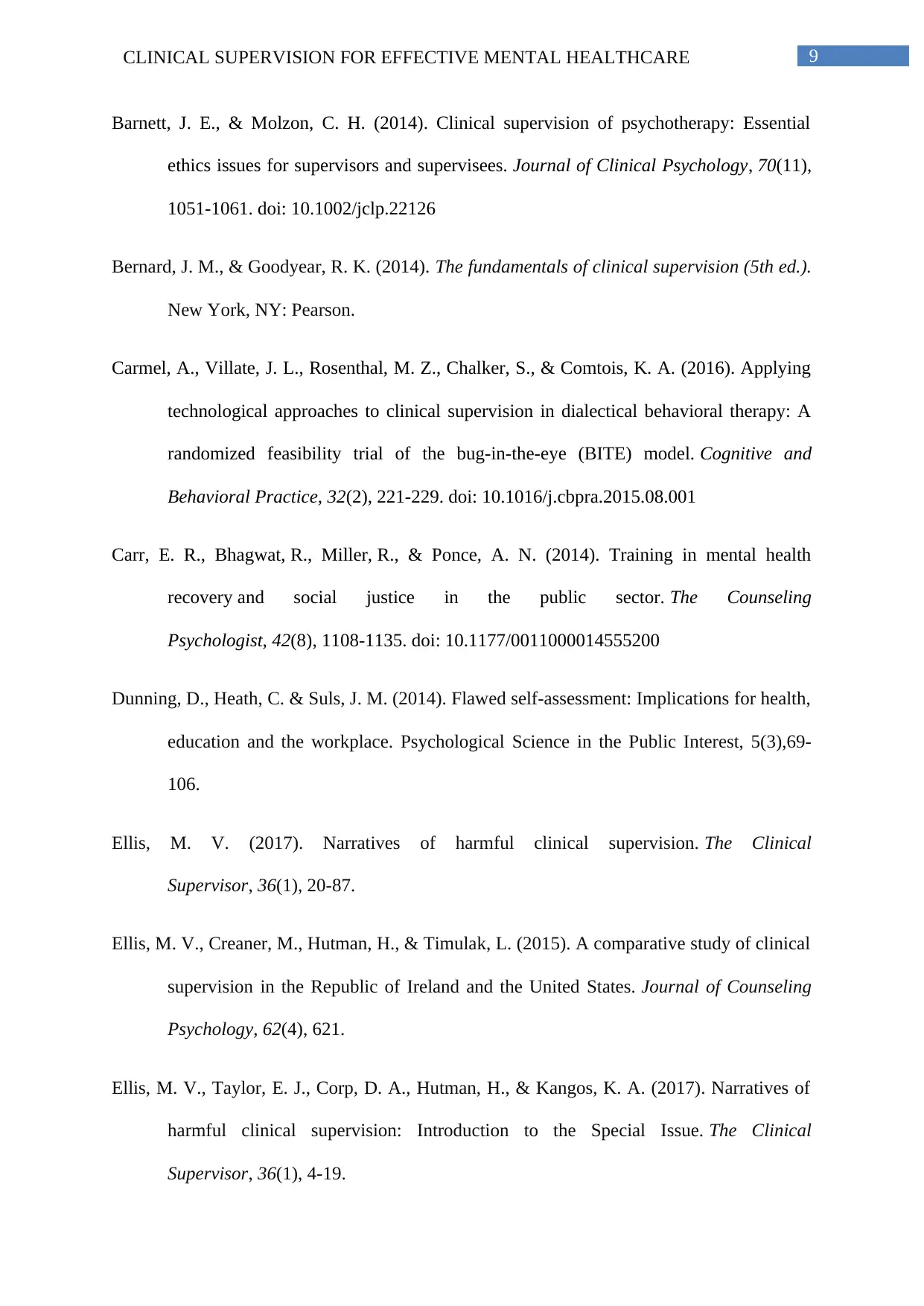
9CLINICAL SUPERVISION FOR EFFECTIVE MENTAL HEALTHCARE
Barnett, J. E., & Molzon, C. H. (2014). Clinical supervision of psychotherapy: Essential
ethics issues for supervisors and supervisees. Journal of Clinical Psychology, 70(11),
1051-1061. doi: 10.1002/jclp.22126
Bernard, J. M., & Goodyear, R. K. (2014). The fundamentals of clinical supervision (5th ed.).
New York, NY: Pearson.
Carmel, A., Villate, J. L., Rosenthal, M. Z., Chalker, S., & Comtois, K. A. (2016). Applying
technological approaches to clinical supervision in dialectical behavioral therapy: A
randomized feasibility trial of the bug-in-the-eye (BITE) model. Cognitive and
Behavioral Practice, 32(2), 221-229. doi: 10.1016/j.cbpra.2015.08.001
Carr, E. R., Bhagwat, R., Miller, R., & Ponce, A. N. (2014). Training in mental health
recovery and social justice in the public sector. The Counseling
Psychologist, 42(8), 1108-1135. doi: 10.1177/0011000014555200
Dunning, D., Heath, C. & Suls, J. M. (2014). Flawed self-assessment: Implications for health,
education and the workplace. Psychological Science in the Public Interest, 5(3),69-
106.
Ellis, M. V. (2017). Narratives of harmful clinical supervision. The Clinical
Supervisor, 36(1), 20-87.
Ellis, M. V., Creaner, M., Hutman, H., & Timulak, L. (2015). A comparative study of clinical
supervision in the Republic of Ireland and the United States. Journal of Counseling
Psychology, 62(4), 621.
Ellis, M. V., Taylor, E. J., Corp, D. A., Hutman, H., & Kangos, K. A. (2017). Narratives of
harmful clinical supervision: Introduction to the Special Issue. The Clinical
Supervisor, 36(1), 4-19.
Barnett, J. E., & Molzon, C. H. (2014). Clinical supervision of psychotherapy: Essential
ethics issues for supervisors and supervisees. Journal of Clinical Psychology, 70(11),
1051-1061. doi: 10.1002/jclp.22126
Bernard, J. M., & Goodyear, R. K. (2014). The fundamentals of clinical supervision (5th ed.).
New York, NY: Pearson.
Carmel, A., Villate, J. L., Rosenthal, M. Z., Chalker, S., & Comtois, K. A. (2016). Applying
technological approaches to clinical supervision in dialectical behavioral therapy: A
randomized feasibility trial of the bug-in-the-eye (BITE) model. Cognitive and
Behavioral Practice, 32(2), 221-229. doi: 10.1016/j.cbpra.2015.08.001
Carr, E. R., Bhagwat, R., Miller, R., & Ponce, A. N. (2014). Training in mental health
recovery and social justice in the public sector. The Counseling
Psychologist, 42(8), 1108-1135. doi: 10.1177/0011000014555200
Dunning, D., Heath, C. & Suls, J. M. (2014). Flawed self-assessment: Implications for health,
education and the workplace. Psychological Science in the Public Interest, 5(3),69-
106.
Ellis, M. V. (2017). Narratives of harmful clinical supervision. The Clinical
Supervisor, 36(1), 20-87.
Ellis, M. V., Creaner, M., Hutman, H., & Timulak, L. (2015). A comparative study of clinical
supervision in the Republic of Ireland and the United States. Journal of Counseling
Psychology, 62(4), 621.
Ellis, M. V., Taylor, E. J., Corp, D. A., Hutman, H., & Kangos, K. A. (2017). Narratives of
harmful clinical supervision: Introduction to the Special Issue. The Clinical
Supervisor, 36(1), 4-19.
Paraphrase This Document
Need a fresh take? Get an instant paraphrase of this document with our AI Paraphraser
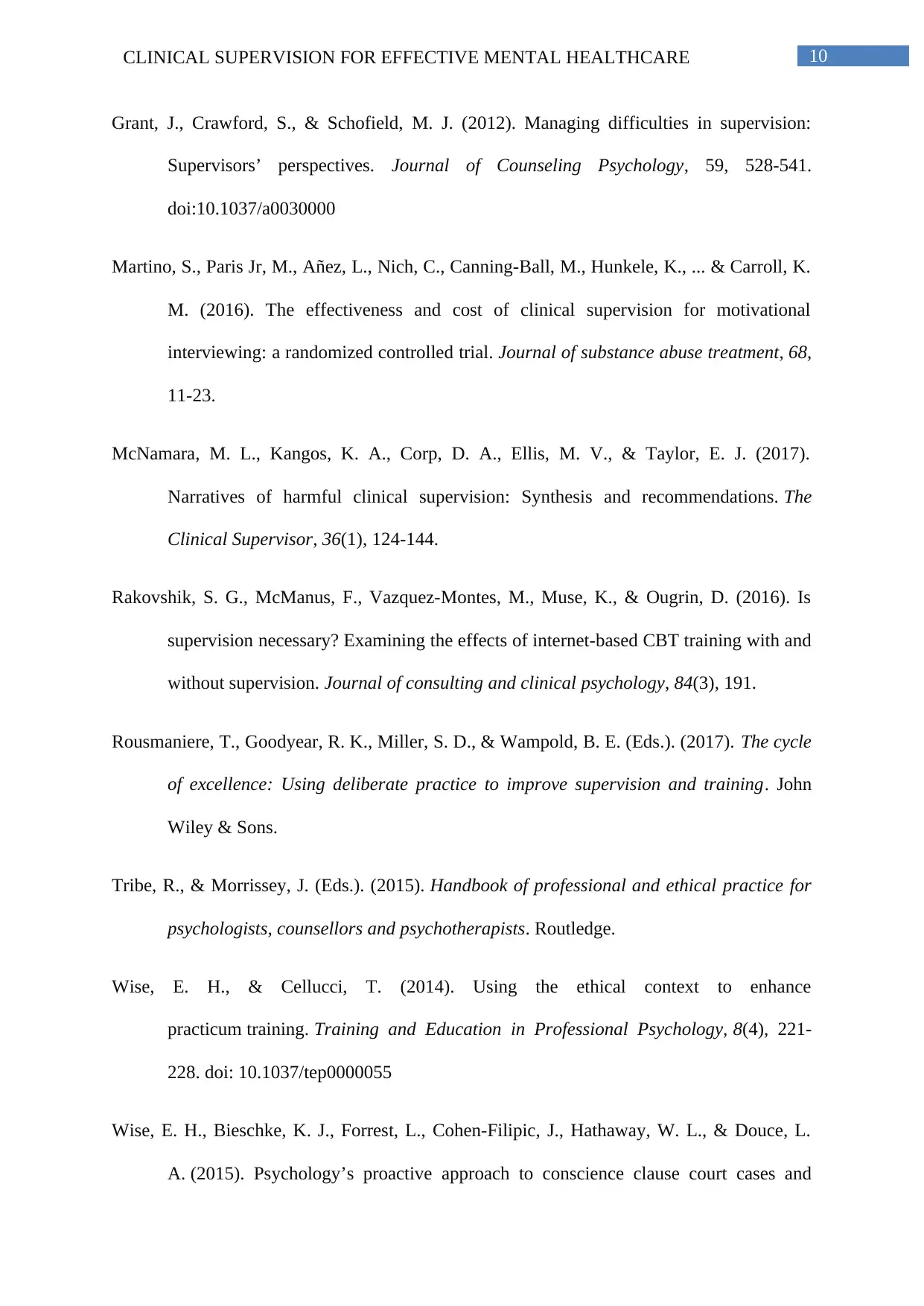
10CLINICAL SUPERVISION FOR EFFECTIVE MENTAL HEALTHCARE
Grant, J., Crawford, S., & Schofield, M. J. (2012). Managing difficulties in supervision:
Supervisors’ perspectives. Journal of Counseling Psychology, 59, 528-541.
doi:10.1037/a0030000
Martino, S., Paris Jr, M., Añez, L., Nich, C., Canning-Ball, M., Hunkele, K., ... & Carroll, K.
M. (2016). The effectiveness and cost of clinical supervision for motivational
interviewing: a randomized controlled trial. Journal of substance abuse treatment, 68,
11-23.
McNamara, M. L., Kangos, K. A., Corp, D. A., Ellis, M. V., & Taylor, E. J. (2017).
Narratives of harmful clinical supervision: Synthesis and recommendations. The
Clinical Supervisor, 36(1), 124-144.
Rakovshik, S. G., McManus, F., Vazquez-Montes, M., Muse, K., & Ougrin, D. (2016). Is
supervision necessary? Examining the effects of internet-based CBT training with and
without supervision. Journal of consulting and clinical psychology, 84(3), 191.
Rousmaniere, T., Goodyear, R. K., Miller, S. D., & Wampold, B. E. (Eds.). (2017). The cycle
of excellence: Using deliberate practice to improve supervision and training. John
Wiley & Sons.
Tribe, R., & Morrissey, J. (Eds.). (2015). Handbook of professional and ethical practice for
psychologists, counsellors and psychotherapists. Routledge.
Wise, E. H., & Cellucci, T. (2014). Using the ethical context to enhance
practicum training. Training and Education in Professional Psychology, 8(4), 221-
228. doi: 10.1037/tep0000055
Wise, E. H., Bieschke, K. J., Forrest, L., Cohen-Filipic, J., Hathaway, W. L., & Douce, L.
A. (2015). Psychology’s proactive approach to conscience clause court cases and
Grant, J., Crawford, S., & Schofield, M. J. (2012). Managing difficulties in supervision:
Supervisors’ perspectives. Journal of Counseling Psychology, 59, 528-541.
doi:10.1037/a0030000
Martino, S., Paris Jr, M., Añez, L., Nich, C., Canning-Ball, M., Hunkele, K., ... & Carroll, K.
M. (2016). The effectiveness and cost of clinical supervision for motivational
interviewing: a randomized controlled trial. Journal of substance abuse treatment, 68,
11-23.
McNamara, M. L., Kangos, K. A., Corp, D. A., Ellis, M. V., & Taylor, E. J. (2017).
Narratives of harmful clinical supervision: Synthesis and recommendations. The
Clinical Supervisor, 36(1), 124-144.
Rakovshik, S. G., McManus, F., Vazquez-Montes, M., Muse, K., & Ougrin, D. (2016). Is
supervision necessary? Examining the effects of internet-based CBT training with and
without supervision. Journal of consulting and clinical psychology, 84(3), 191.
Rousmaniere, T., Goodyear, R. K., Miller, S. D., & Wampold, B. E. (Eds.). (2017). The cycle
of excellence: Using deliberate practice to improve supervision and training. John
Wiley & Sons.
Tribe, R., & Morrissey, J. (Eds.). (2015). Handbook of professional and ethical practice for
psychologists, counsellors and psychotherapists. Routledge.
Wise, E. H., & Cellucci, T. (2014). Using the ethical context to enhance
practicum training. Training and Education in Professional Psychology, 8(4), 221-
228. doi: 10.1037/tep0000055
Wise, E. H., Bieschke, K. J., Forrest, L., Cohen-Filipic, J., Hathaway, W. L., & Douce, L.
A. (2015). Psychology’s proactive approach to conscience clause court cases and
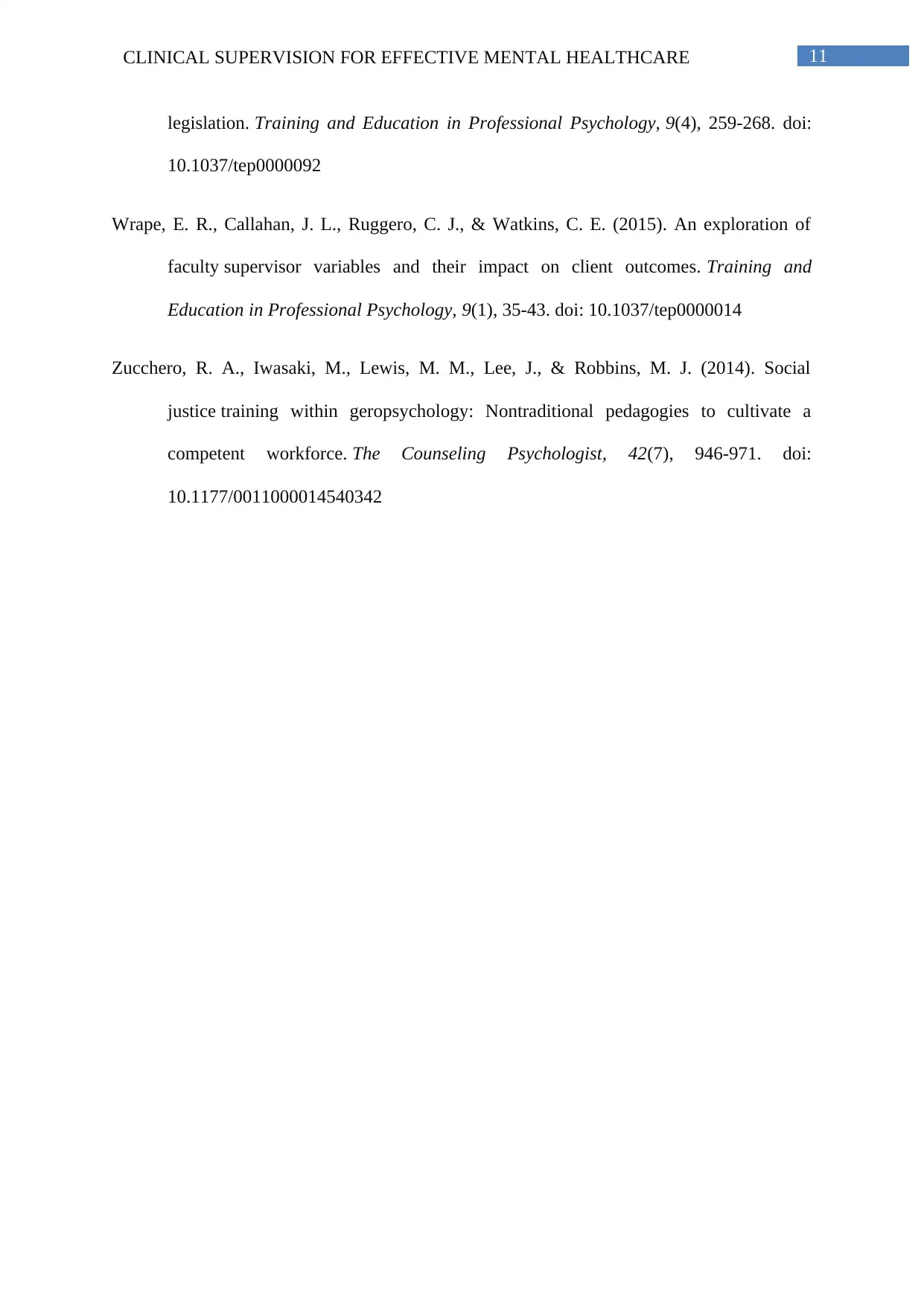
11CLINICAL SUPERVISION FOR EFFECTIVE MENTAL HEALTHCARE
legislation. Training and Education in Professional Psychology, 9(4), 259-268. doi:
10.1037/tep0000092
Wrape, E. R., Callahan, J. L., Ruggero, C. J., & Watkins, C. E. (2015). An exploration of
faculty supervisor variables and their impact on client outcomes. Training and
Education in Professional Psychology, 9(1), 35-43. doi: 10.1037/tep0000014
Zucchero, R. A., Iwasaki, M., Lewis, M. M., Lee, J., & Robbins, M. J. (2014). Social
justice training within geropsychology: Nontraditional pedagogies to cultivate a
competent workforce. The Counseling Psychologist, 42(7), 946-971. doi:
10.1177/0011000014540342
legislation. Training and Education in Professional Psychology, 9(4), 259-268. doi:
10.1037/tep0000092
Wrape, E. R., Callahan, J. L., Ruggero, C. J., & Watkins, C. E. (2015). An exploration of
faculty supervisor variables and their impact on client outcomes. Training and
Education in Professional Psychology, 9(1), 35-43. doi: 10.1037/tep0000014
Zucchero, R. A., Iwasaki, M., Lewis, M. M., Lee, J., & Robbins, M. J. (2014). Social
justice training within geropsychology: Nontraditional pedagogies to cultivate a
competent workforce. The Counseling Psychologist, 42(7), 946-971. doi:
10.1177/0011000014540342
⊘ This is a preview!⊘
Do you want full access?
Subscribe today to unlock all pages.

Trusted by 1+ million students worldwide
1 out of 12
Your All-in-One AI-Powered Toolkit for Academic Success.
+13062052269
info@desklib.com
Available 24*7 on WhatsApp / Email
![[object Object]](/_next/static/media/star-bottom.7253800d.svg)
Unlock your academic potential
Copyright © 2020–2025 A2Z Services. All Rights Reserved. Developed and managed by ZUCOL.


